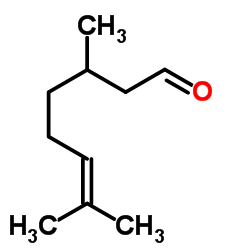Citronella oil

Citronella oil structure
|
Common Name | Citronella oil | ||
|---|---|---|---|---|
| CAS Number | 8000-29-1 | Molecular Weight | 154.249 | |
| Density | 0.8±0.1 g/cm3 | Boiling Point | 208.4±9.0 °C at 760 mmHg | |
| Molecular Formula | C10H18O | Melting Point | N/A | |
| MSDS | Chinese USA | Flash Point | 75.6±0.0 °C | |
| Symbol |



GHS05, GHS07, GHS08 |
Signal Word | Danger | |
|
Repellency of DEET, picaridin, and three essential oils to Triatoma rubida (Hemiptera: Reduviidae: Triatominae).
J. Med. Entomol. 50(3) , 664-7, (2013) The kissing bug, Triatoma rubida (Uhler) is a common hematophagous bug in Tucson, AZ, and is responsible for causing severe allergic reactions in some bitten individuals. DEET, picaridin, tea tree oil, peppermint oil, and citronella oil were tested for repell... |
|
|
Citronellal, a monoterpene present in Java citronella oil, attenuates mechanical nociception response in mice.
Pharm. Biol. 51(9) , 1144-9, (2013) Citronellal is a monoterpene present in the oil of many species, including Cymbopogon winterianus Jowitt (Poaceae).The present study investigated the effect of citronellal on inflammatory nociception induced by different stimuli and examined the involvement o... |
|
|
Chemical composition, larvicidal action, and adult repellency of Thymus magnus against Aedes albopictus.
J. Am. Mosq. Control Assoc. 28(3) , 192-8, (2012) Thymus magnus, an endemic species, is found in the Republic of Korea. The volatile compounds extracted by SPME from T. magnus were investigated for their chemical composition and electrophysiological response against the Asian tiger mosquito, Aedes albopictus... |
|
|
Does anything beat DEET?
Pediatr. Ann. 33(7) , 443-53, (2004) In comparison trials, DEET is more effective than any other insect repellent. Despite some reports of serious adverse events, when comparing the thousands of other reports of exposure and millions of past users, DEET has a good safety record. The appropriate ... |
|
|
Evaluation of commercial products for personal protection against mosquitoes.
Acta Trop. 125(2) , 226-30, (2013) Human landing catch studies were conducted in a semi-field setting to determine the efficacy of seven commercial products used for personal protection against mosquitoes. Experiments were conducted in two empty, insecticide free, mesh-enclosed greenhouses, in... |
|
|
Repellent effect of plant essential oils against Aedes albopictus.
J. Vector Ecol. 30(2) , 231-4, (2005) Six essential oils: asteraceae oil, rutaceae oil, mentha piperta oil, carvacryl oil, citronella oil, and eucalyptus oil were tested for evaluation of their repellent effects against Aedes albopictus mosquitoes under laboratory conditions. Only citronella oil ... |
|
|
Effects of natal habitat odour, reinforced by adult experience, on choice of oviposition site in the mosquito Aedes aegypti.
Med. Vet. Entomol. 25(4) , 428-35, (2011) The effects of natal experience on the oviposition behaviour of adult female mosquitoes were investigated in the laboratory using Aedes aegypti (L.) (Diptera: Culicidae). 'Treatment' mosquitoes were exposed to a dilute repellent (inducing stimulus) in their b... |
|
|
Duration of repellency of N,N-diethyl-3-methylbenzamide, citronella oil and cypermethrin against Culicoides species when applied to polyester mesh.
Vet. Parasitol. 163(1-2) , 105-9, (2009) The repellent efficacy of 15% N,N-diethyl-3-methylbenzamide (DEET), 0.6% citronella oil, and 0.3% alpha-cyano-cypermethrin against Culicoides species was compared in three 5x5 Latin squares (15 replicates) under South African field conditions. DEET, citronell... |
|
|
Repellency of aerosol and cream products containing fennel oil to mosquitoes under laboratory and field conditions.
Pest Manag. Sci. 60(11) , 1125-30, (2004) The repellency of fennel (Foeniculum vulgare Miller)-containing products (5% aerosol and 8% cream) against mosquitoes was compared with those of citronella oil, geranium oil and deet, as well as three commercial repellents, Baby Keeper cream containing IR3535... |
|
|
Antigenotoxic and antioxidant activities of palmarosa and citronella essential oils.
J. Ethnopharmacol. 137(3) , 1521-7, (2011) Essential oils of palmarosa and citronella have been extensively used in ancient Indian and South-east Asian traditional medicines.These essential oils have been reported to exhibit antimicrobial, anti parasitic effects against bacteria, yeasts, filamentous f... |